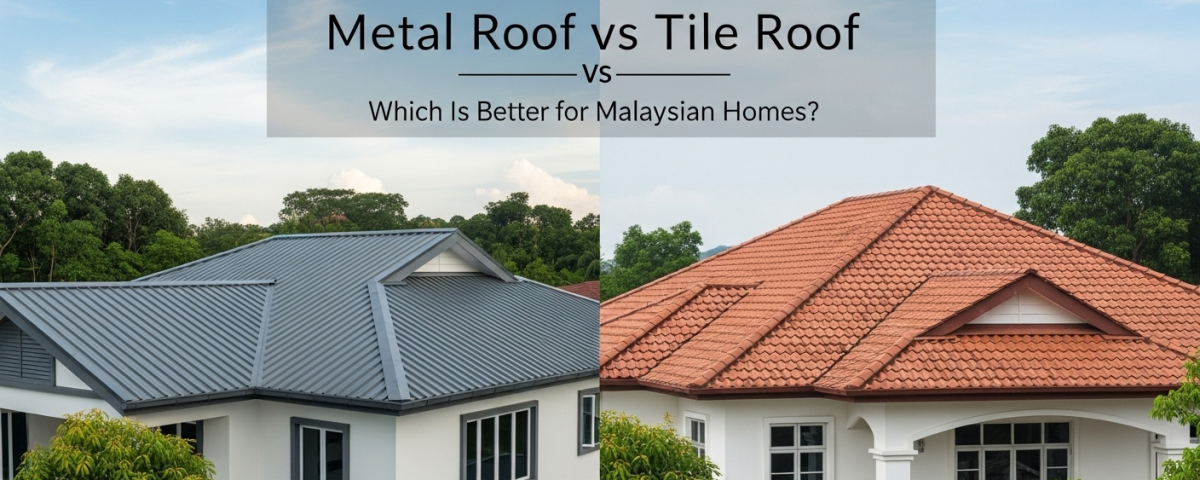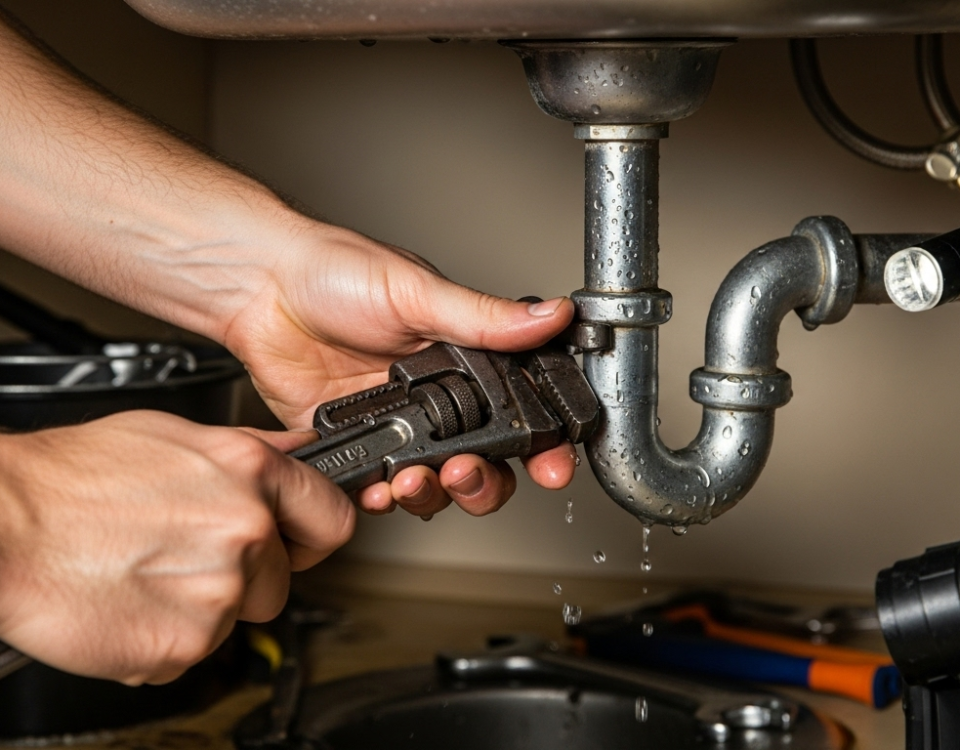Metal Roof vs Tile Roof: Which Is Better for Malaysian Homes?

What Is a Downspout? And What Is Its Purpose?
July 22, 2025
Why Your Roof and Plumbing Are More Connected Than You Think
August 5, 2025Introduction
Selecting the appropriate roofing for your residence in Malaysia is a crucial choice, influencing various factors such as appearance, longevity, energy efficiency, and overall expenses. In a tropical environment like that of Malaysia, characterized by substantial rainfall, intense sunlight, and sporadic strong winds, the choice of roofing material is vital. This analysis of metal roofs versus tile roofs is designed to assist you in making a well-informed decision.
1. Durability and Lifespan
Metal Roof
- Weather Resistance:
Designed to withstand Malaysia’s harsh conditions — heavy rain, strong winds, and intense heat. - Materials Used:
Typically made from galvanized steel or aluminum with anti-rust, anti-corrosion coatings. - Lifespan:
Ranges from 40 to 70 years; premium types can exceed this range. - Pest and Crack Resistance:
Excellent at resisting cracks, insects, and rodents. - Maintenance & Cost:
Low maintenance and fewer replacements lead to long-term cost savings.
Tile Roof
- Materials Used:
Made from clay or concrete, known for their strength and classic appearance. - Lifespan:
Usually lasts 50+ years, with some types reaching 100 years with proper care. - Fire & Heat Resistance:
Naturally resistant to fire and helps reduce indoor temperatures. - Insect & Rot Protection:
Naturally resists damage from insects and rotting. - Weight & Structure:
Heavier than metal roofs — may require stronger roof framing.
While both roofing types offer excellent durability, metal has a slight advantage in resisting cracking and pests, whereas tile excels in heat and fire resistance.
2. Energy Efficiency and Heat Insulation
Metal Roof
-
Solar Heat Reflection:
Naturally reflects sunlight, reducing heat absorption and keeping interiors cooler. -
Reduced Cooling Costs:
Helps lower reliance on air conditioning, especially during hot Malaysian afternoons. -
Insulation Compatibility:
Performs even better when combined with insulation like PU foam or foil-backed layers. -
Tropical Climate Advantage:
Excellent choice for Malaysia’s hot, humid weather due to superior thermal control.
Tile Roof
- Thermal Mass Benefit:
Clay or concrete tiles absorb and slowly release heat, helping regulate temperature indoors. -
Lower Reflectivity:
Less effective at reflecting heat compared to metal roofs. -
Needs Extra Insulation:
Additional insulation is often required beneath the tiles for optimal comfort. -
Passive Cooling Support:
Offers decent insulation but not ideal for high heat-exposure without enhancements.
Overall, both roofing types can support energy efficiency, but metal roofs have a clear advantage when it comes to reflecting heat and minimizing cooling costs. For homeowners in Malaysia looking to maximize indoor comfort and reduce energy bills, a well-insulated metal roof is often the more effective solution.
3. Aesthetics and Design Versatility
Metal Roof
-
Modern Look:
Offers a clean, sleek aesthetic that enhances contemporary home designs. -
Versatile Styles:
Available in profiles like standing seam, corrugated panels, or metal shingles that can mimic wood or tile. -
Color & Finish Variety:
Comes in a wide range of colors, coatings, and finishes to match various architectural styles. -
Flexible Design Compatibility:
Suitable for both modern and traditional homes.
Tile Roof
-
Timeless & Classic:
Brings an elegant, traditional look, perfect for Mediterranean, colonial, or heritage-style homes. -
Natural Materials:
Made from clay or concrete, giving a textured, handcrafted appearance. -
Limited Colors, Rich Texture:
Fewer color options (mostly earth tones), but distinctive shapes and forms create strong visual character. -
Curb Appeal:
Enhances home value and charm through its classic, enduring style.
Both roofing types offer aesthetic value, but the choice depends on your architectural style and design goals. Metal roofing stands out for its modern flair and broader color range, while tile roofing remains a go-to for those seeking a more classic and elegant appearance.
4. Weight and Structural Requirements
Metal Roof
-
Lightweight Yet Durable:
Weighs around 50% less than traditional tile roofs, reducing structural load. -
Ideal for Older Homes:
Suitable for buildings with weaker or aging support systems. -
Easier Installation:
Lighter weight simplifies handling, transport, and installation process. -
Versatile Application:
Can be used on a wide variety of building types, including renovations and retrofits.
Tile Roof
-
Heavy Roofing Material:
Made from clay or concrete, significantly heavier than metal alternatives. -
Requires Strong Structure:
Needs a well-supported frame to carry the weight safely. -
Extra Reinforcement May Be Needed:
Older homes may require costly structural upgrades before tile roof installation. -
Best for New Builds:
More suitable for new constructions or homes built with reinforced trusses.
Overall, metal roofs offer a practical advantage in terms of weight and installation flexibility. Their lighter load reduces the need for additional structural support, potentially lowering installation time and costs—especially for retrofitting or upgrading older buildings.
5. Noise
Metal Roof
-
Rain Noise Concern:
Can be noisier during heavy rain if not properly insulated. -
Soundproofing Solutions:
Insulation materials like PU foam or reflective foil greatly reduce noise. -
Attic Insulation Advantage:
A well-insulated attic further helps dampen sound. -
Comparable with Proper Setup:
When insulated correctly, noise levels are similar to tile or shingle roofs.
Tile Roof
-
Naturally Quieter:
Heavier mass and dense structure absorb rain impact, reducing noise. -
Minimal Insulation Needed:
Often no need for additional insulation to manage rain sounds. -
Ideal for Noise Sensitivity:
Preferred by homeowners who value quiet indoor environments. -
Consistent Acoustic Comfort:
Offers a consistently calm sound profile without upgrades.
While it is true that metal roofs can be noisier when uninsulated, contemporary insulation methods are highly effective in lowering sound levels. When installed correctly, both metal and tile roofs can provide a serene and comfortable indoor atmosphere, even amidst the heavy downpours experienced in Malaysia.
6. Maintenance
Metal Roof
-
Low Maintenance:
Requires only occasional cleaning and routine inspections. -
Weather & Moisture Resistant:
Protective coatings resist rust, moss, and mold—ideal for Malaysia’s humid climate. -
Common Minor Issues:
Potential for leaks at screw holes or worn flashing sealants over time. -
Easy Repairs:
Most issues are simple and inexpensive to fix.
Tile Roof
-
Minimal Upkeep Needed:
Regular cleaning and inspections help maintain longevity. -
Fragility Concern:
Tiles can crack due to heavy impact or harsh weather. -
Straightforward Replacement:
Damaged tiles are easy to replace, but must be handled with care to avoid breaking nearby ones. -
Appearance Preservation:
Cleaning prevents dirt, moss, and debris buildup, keeping the roof visually appealing.
Both roofing types require relatively low maintenance, yet they differ in the nature of care needed. Metal roofs exhibit greater resistance to physical damage and weathering, whereas tile roofs may require more frequent spot replacements due to breakage. With appropriate maintenance, either choice can provide homeowners with reliable service for many years.
Conclusion
For Malaysian homeowners, both metal and tile roofs offer strong benefits, but the right choice depends on your specific needs and home structure. Metal roofs are ideal if you value long-term durability, energy efficiency, modern design, and lighter weight—making them especially suitable for older or lighter buildings. Tile roofs, on the other hand, are perfect for those who prefer a timeless look and natural resistance to fire, insects, and rot, provided the home’s structure can handle the weight. While metal may require a higher upfront investment, it often pays off through lower maintenance and energy savings. In contrast, tile roofing may involve occasional tile replacement but delivers unmatched classic appeal. To make the most informed decision, it’s best to consult a trusted local roofing expert who understands Malaysia’s climate and building conditions.


